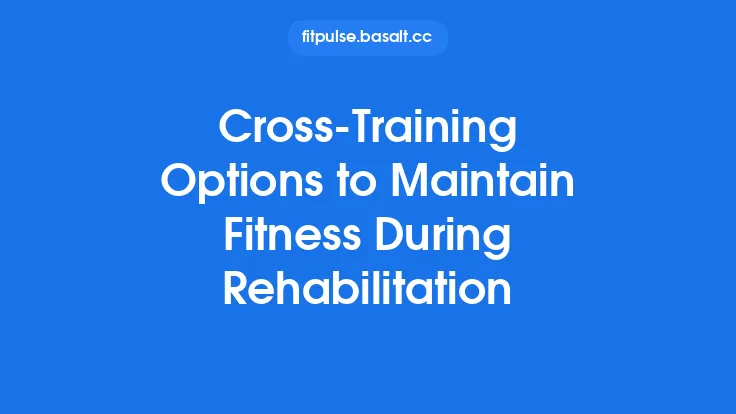Cross‑training has become a cornerstone of sustainable performance for athletes who continue to compete well into their 40s, 50s, and beyond. While the primary sport remains the focal point of training, incorporating complementary activities can protect the aging musculoskeletal system, preserve cardiovascular capacity, and keep motivation high. This article explores a range of cross‑training options that senior and masters competitors can use to extend their competitive lifespan, with practical guidance on selection, integration, and progression.
Understanding the Role of Cross‑Training for Masters Athletes
Aging brings predictable physiological changes: reduced maximal oxygen uptake (VO₂max), slower mitochondrial turnover, decreased muscle fiber recruitment efficiency, and a gradual loss of joint cartilage elasticity. These shifts do not preclude high‑level competition, but they do demand a more nuanced approach to stimulus distribution. Cross‑training offers several distinct advantages:
- Systemic Cardiovascular Load with Reduced Joint Stress – Activities such as swimming or cycling provide a high cardiac output while sparing weight‑bearing joints that are more vulnerable to osteoarthritic changes.
- Neuromuscular Variety – Engaging different movement patterns recruits motor units that may be under‑utilized in the primary sport, helping to maintain overall coordination and reduce the risk of sport‑specific overuse.
- Psychological Refreshment – A change of scenery and movement can break monotony, supporting long‑term adherence without delving into mental‑training techniques.
- Metabolic Flexibility – Alternating between aerobic‑dominant and mixed‑modal sessions encourages the body to oxidize both fats and carbohydrates efficiently, a key factor in preserving endurance performance as glycogen storage capacity declines with age.
The overarching goal is to create a balanced stimulus portfolio that supports the primary sport while mitigating the cumulative wear that can accelerate performance decline.
Selecting Complementary Modalities
When choosing cross‑training activities, masters athletes should consider three primary criteria:
| Criterion | Why It Matters | Example Options |
|---|---|---|
| Impact Load | Lower‑impact modalities protect joints and reduce cumulative micro‑trauma. | Swimming, rowing, stationary cycling, elliptical training |
| Movement Plane Diversity | Engaging sagittal, frontal, and transverse planes improves overall functional stability. | Pilates (core control), Tai Chi (slow, multi‑planar flow), agility ladder drills |
| Energy System Emphasis | Matching the dominant energy system of the primary sport helps maintain specificity while providing variety. | High‑intensity interval rowing for middle‑distance runners; steady‑state cycling for triathletes |
A well‑rounded cross‑training program typically blends at least two low‑impact cardio options, one functional movement practice, and one neuromuscular coordination activity each week.
Aerobic Cross‑Training: Swimming, Cycling, Rowing, and Elliptical Training
1. Swimming
- Physiological Profile: Primarily utilizes the aerobic system with intermittent anaerobic bursts during sprint intervals. The buoyant environment eliminates ground reaction forces, making it ideal for athletes with knee or hip concerns.
- Key Benefits: Enhances lung capacity, improves upper‑body muscular endurance, and promotes efficient breathing patterns that translate to better pacing in land‑based events.
- Programming Tips:
- Endurance Sets: 4–6 × 400 m at a moderate pace with 30 s rest.
- Technique Focus: Incorporate drills (e.g., fingertip drag, catch‑up) to reinforce efficient stroke mechanics without overloading the shoulders.
2. Cycling (Road or Stationary)
- Physiological Profile: Sustained sub‑maximal effort predominantly stresses the oxidative phosphorylation pathway, while short high‑cadence bursts can stimulate phosphocreatine recovery.
- Key Benefits: Maintains leg‑muscle endurance, preserves cardiovascular fitness, and allows precise control over cadence and resistance.
- Programming Tips:
- Tempo Ride: 60–90 min at 70–80 % of perceived effort, focusing on smooth pedal stroke.
- Cadence Drills: 5 × 2 min at 100–110 rpm with 2 min easy spin to improve neuromuscular firing patterns.
3. Rowing (Machine or On‑Water)
- Physiological Profile: Engages both upper and lower body in a coordinated, full‑body power output, stressing the aerobic system while providing brief anaerobic spikes during the drive phase.
- Key Benefits: Strengthens the posterior chain, improves postural control, and offers a low‑impact alternative that still challenges the cardiovascular system.
- Programming Tips:
- Steady State: 30 min at a consistent split time (e.g., 2:30 / 500 m) focusing on rhythm.
- Interval Block: 8 × 250 m at a hard effort with 1 min active recovery.
4. Elliptical Training
- Physiological Profile: Simulates a running gait without the impact forces, allowing for high‑volume aerobic work.
- Key Benefits: Provides a familiar movement pattern for runners while reducing stress on the knees and ankles.
- Programming Tips:
- Long Duration: 45–60 min at a moderate resistance, maintaining a steady heart rate within the aerobic zone (use perceived exertion if heart‑rate zones are avoided).
- Reverse Pedal Intervals: 5 × 3 min reverse motion to engage different muscle groups and improve balance.
Strength‑Enduring Cross‑Training: Resistance Circuits, Bodyweight Complexes, and Kettlebell Flow
While the article does not delve into traditional strength training protocols, incorporating endurance‑oriented resistance work can complement aerobic cross‑training by preserving muscle quality without excessive hypertrophy.
- Circuit Design: 8–10 stations, each lasting 30–45 seconds, with 15 seconds transition. Use light to moderate loads (30–50 % of 1RM) to emphasize muscular endurance.
- Bodyweight Complexes: Sequences such as push‑up → plank row → squat → reverse lunge, performed continuously for 3–4 minutes, develop functional strength and core stability.
- Kettlebell Flow: Movements like the “Turkish get‑up” and “windmill” performed at a controlled tempo improve shoulder stability and hip mobility while providing a cardiovascular stimulus.
These modalities reinforce the kinetic chain used in the primary sport, helping to maintain force transmission efficiency as muscle fibers age.
Neuromuscular Coordination and Balance: Pilates, Tai Chi, and Agility Drills
Aging often leads to diminished proprioception and slower reaction times. Integrating coordination‑focused practices can counteract these declines.
- Pilates (Mat or Reformer): Emphasizes core activation, spinal alignment, and controlled breathing. Sessions of 45 minutes, focusing on the “hundred,” “roll‑up,” and “single‑leg stretch,” improve trunk stability essential for virtually every sport.
- Tai Chi: Slow, deliberate movements enhance joint awareness and balance. A typical 20‑minute routine (e.g., “Wave Hands Like Clouds”) can be performed daily, fostering neuromuscular integration without cardiovascular overload.
- Agility Drills: Ladder footwork, cone shuffles, and short “react‑to‑light” patterns sharpen foot speed and decision‑making. Keep intensity moderate (RPE 5–6) and limit total volume to 10–15 minutes per session to avoid excessive fatigue.
These activities are especially valuable for masters athletes competing in sports that require rapid direction changes (e.g., basketball, soccer, tennis).
Flexibility‑Preserving Cross‑Training: Dynamic Stretching Routines and Mobility‑Focused Flow
Although dedicated mobility articles are out of scope, a brief inclusion of dynamic flexibility work is appropriate within a cross‑training context.
- Dynamic Warm‑Up: Leg swings, arm circles, and walking lunges performed for 2 minutes each prime the musculoskeletal system before any cross‑training session.
- Mobility Flow: A 10‑minute sequence combining cat‑cow, thoracic rotations, and ankle dorsiflexion drills can be performed post‑session to maintain range of motion without the depth of a full mobility program.
These brief interventions help preserve the functional length‑tension relationships needed for sport‑specific performance.
Integrating Cross‑Training into a Competitive Schedule
A practical integration strategy respects the primary sport’s competition calendar while providing sufficient recovery between high‑intensity sessions.
| Weekday | Primary Sport | Cross‑Training Modality | Approx. Duration | Intensity (RPE) |
|---|---|---|---|---|
| Monday | Technique/Skill | Light swimming (recovery) | 30 min | 3–4 |
| Tuesday | High‑intensity interval | Rowing intervals | 45 min | 6–7 |
| Wednesday | Rest or active recovery | Yoga/Pilates flow | 45 min | 2–3 |
| Thursday | Endurance long run | Cycling (steady) | 60 min | 5–6 |
| Friday | Strength/Power | Kettlebell circuit | 30 min | 5–6 |
| Saturday | Competition or race | Optional light elliptical | 30 min | 3–4 |
| Sunday | Full rest | Gentle walking or Tai Chi | 20 min | 2 |
Key Points for Scheduling
- Alternate Load Types: Pair high‑impact or high‑intensity primary sport days with low‑impact cross‑training to balance mechanical stress.
- Periodic Deload Weeks: Every 4–6 weeks, replace one or two cross‑training sessions with a purely restorative activity (e.g., gentle swimming) to allow systemic recovery.
- Seasonal Adjustments: In off‑season, increase cross‑training volume to maintain aerobic base; during competition season, reduce volume but keep frequency to preserve neuromuscular benefits.
Monitoring Progress without Wearables: Simple Metrics and Journaling
While sophisticated wearables are excluded, masters athletes can still track meaningful data using low‑tech methods:
- Perceived Exertion (RPE) Scale: Record a 1–10 rating after each cross‑training session; trends toward lower RPE for the same duration indicate improved efficiency.
- Session Duration and Distance: Log total minutes and, where applicable, distance (e.g., meters swum, kilometers cycled). Incremental increases reflect aerobic adaptations.
- Recovery Questionnaires: Briefly note muscle soreness, sleep quality, and overall energy each morning; persistent high soreness may signal overuse.
- Performance Benchmarks: Quarterly time trials (e.g., 5 km bike, 500 m row) provide objective data on cardiovascular maintenance.
A simple spreadsheet or notebook can capture these variables, offering a clear picture of how cross‑training contributes to overall performance longevity.
Practical Sample Week for Different Sports
1. Masters Runner
- Monday: 30 min easy swim (focus on breathing) – RPE 3
- Tuesday: 45 min rowing intervals (8 × 250 m) – RPE 6
- Wednesday: Pilates mat session – RPE 2
- Thursday: 60 min steady‑state bike (70 % effort) – RPE 5
- Friday: Bodyweight circuit (push‑ups, lunges, planks) – RPE 5
- Saturday: Race or long run (primary sport)
- Sunday: Rest or gentle Tai Chi – RPE 2
2. Masters Swimmer
- Monday: 45 min stationary bike (recovery) – RPE 4
- Tuesday: 30 min elliptical (reverse pedal) – RPE 5
- Wednesday: Kettlebell flow (light weight) – RPE 5
- Thursday: 60 min rowing (steady) – RPE 5
- Friday: Dynamic stretching + mobility flow – RPE 2
- Saturday: Competition swim meet
- Sunday: Light walk + Tai Chi – RPE 2
3. Masters Team‑Sport Athlete (e.g., Basketball)
- Monday: 30 min low‑impact cycling – RPE 4
- Tuesday: Agility ladder + cone drills – RPE 6
- Wednesday: Pilates core session – RPE 3
- Thursday: 45 min rowing intervals – RPE 6
- Friday: Light swim (recovery) – RPE 3
- Saturday: Game or high‑intensity practice (primary sport)
- Sunday: Rest or gentle walking – RPE 2
These templates illustrate how cross‑training can be woven around sport‑specific demands while respecting recovery needs.
Common Pitfalls and How to Avoid Overtraining in Cross‑Training
- Excessive Volume on Low‑Impact Days – It’s tempting to “do more” because the activity feels easy. Keep total weekly cross‑training time to 3–5 hours to prevent cumulative fatigue.
- Neglecting Specificity – Over‑emphasizing a modality unrelated to the primary sport (e.g., excessive upper‑body rowing for a sprinter) can dilute sport‑specific adaptations. Choose cross‑training that mirrors the movement patterns or energy systems of the main discipline.
- Ignoring Early Warning Signs – Persistent elevated RPE, lingering soreness, or decreased motivation are early indicators of overload. Reduce intensity or replace a session with a restorative activity.
- Lack of Progression – Stagnant stimulus leads to plateaus. Incrementally increase duration, distance, or cadence every 2–3 weeks, while maintaining low impact.
By staying mindful of these factors, masters athletes can reap the longevity benefits of cross‑training without compromising performance.
Long‑Term Benefits: Extending Competitive Longevity
When applied consistently, cross‑training delivers a suite of physiological and functional advantages that directly translate to prolonged competitive viability:
- Preserved VO₂max: Low‑impact aerobic modalities maintain cardiac output and mitochondrial density, slowing the typical age‑related decline.
- Enhanced Muscular Endurance: Repetitive, moderate‑load circuits keep type I fibers active, supporting sustained effort in events ranging from distance running to rowing.
- Improved Joint Health: Reduced repetitive loading on primary sport joints mitigates cartilage wear, allowing athletes to train harder for longer periods.
- Superior Neuromuscular Control: Balance and coordination drills counteract age‑related declines in proprioception, reducing the likelihood of falls or missteps during competition.
- Psychological Resilience: Variety in training keeps motivation high, a subtle yet powerful factor in maintaining a multi‑decade athletic career.
Collectively, these outcomes create a robust foundation that enables senior and masters athletes to continue competing at high levels, whether chasing personal bests, qualifying for age‑group championships, or simply enjoying the thrill of sport.
In summary, cross‑training is not an ancillary add‑on but a strategic pillar for masters athletes seeking to extend their competitive lifespan. By selecting low‑impact, movement‑diverse modalities, integrating them thoughtfully into the training calendar, and monitoring progress with simple, reliable metrics, senior competitors can safeguard their bodies, sharpen their skills, and stay on the podium for years to come.





